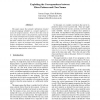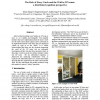782 search results - page 80 / 157 » Ethnographically informed analysis for software engineers |
SCAM
2008
IEEE
14 years 3 months ago
2008
IEEE
This paper argues that semantic information encoded in natural language identifiers is a largely neglected resource for program analysis. First we show that words in Java class n...
AGILEDC
2006
IEEE
14 years 3 months ago
2006
IEEE
Much of the knowledge used within an XP team is tacit, i.e. it is hidden and intangible. Two tangible artefacts that carry information about the team’s work are the index cards ...
IUI
2005
ACM
14 years 2 months ago
2005
ACM
When designing mixed-initiative systems, full formalization of all potentially relevant knowledge may not be cost-effective or practical. This paper motivates the need for semi-fo...
SCAM
2002
IEEE
14 years 1 months ago
2002
IEEE
Dynamic program slicing is an effective technique for narrowing the errors to the relevant parts of a program when debugging. Given a slicing criterion, the dynamic slice contains...
KBSE
2007
IEEE
14 years 3 months ago
2007
IEEE
Threat modeling analyzes how an adversary might attack a system by supplying it with malicious data or interacting with it. The analysis uses a Data Flow Diagram (DFD) to describe...


